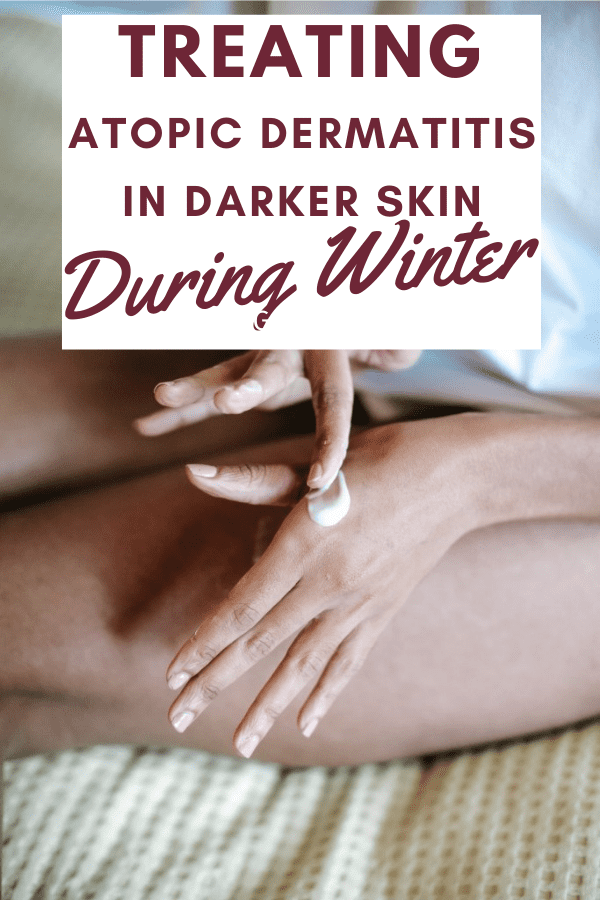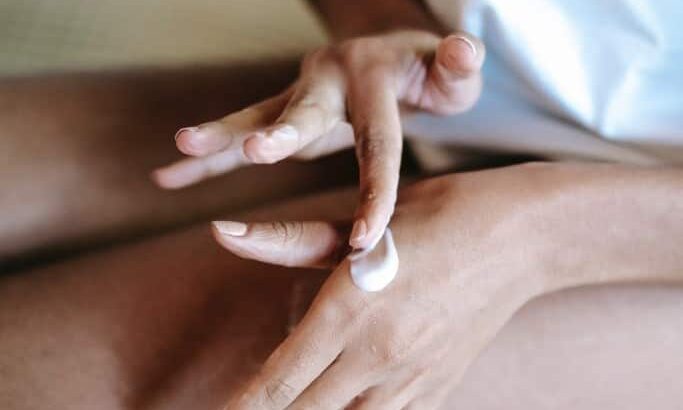Winter has descended on so many of us quickly. This month alone, regions around the United States have received several inches of snow, and some of us, while happy with the white flakes falling from the sky, aren’t dealing too well with the dry, itchy, flaky skin that flares up when the air gets colder and less humid. That's why it's important for us to talk about treating atopic dermatitis during winter

We’re going to talk about atopic dermatitis, known to many of us as atopic eczema in today’s post, and the steps that we can take to treat African American, Black, and Hispanic skin types, which are more likely to have more severe cases than White skin types.
I was compensated by Med-IQ through an educational grant from Pfizer, Inc. to write about the signs, symptoms, and treatments available for eczema/atopic dermatitis in communities of color. All opinions are my own.
Make sure to complete the survey at the end of the article, which takes less than 10 minutes. 10 people will win 1 $100 Visa gift card for their participation.
Before we dive into the ‘treatment ladder’ for atopic eczema, I wanted to give you all the opportunity to check out some work that a colleague did in partnership with Med-IQ
Take a listen to the interview that Jeanette Kaplun of Hispana Global did with dermatologist Dr. Andrew Alexis to learn valuable information on treating eczema in Black skin and other skin with deeper melanin. Included in this interview are the latest treatment options and how to best utilize telemedicine to access a skin care professional.
Treating Atopic Dermatitis using the Treatment Ladder
So, that treatment ladder I spoke of above? It’s a series of steps that you can use to treat the flares that you may have this season. Starting with the easiest and climbing up as severity increases is the best bet for all of us who deal with this skin condition. Obviously, you want to consult your dermatologist to make sure that the treatment you use is best for you.

Basic Skin Care
It’s important to use gentle skincare treatments even more so during the winter. Using harsh soaps, and super hot water can dry your skin out and exacerbate atopic dermatitis flares. The key is using soaps and cleansers that are oil-based with no preservatives and moisturizers for the skin. For some people, this step can be enough, but it can also be pricey. I mean, have you SEEN those moisturizers that are marked for eczema care? We purchase them often to help my youngest daughter and myself, and we pay a pretty penny. But, it's worth it to make sure that she doesn’t have skin that is giving her problems.
For my sister, Jessica, when she was little, she couldn’t eat anything with dairy in it, as it would cause itching FITS. Identifying the triggers with my youngest daughter and myself took a bit more work. I know that I can’t use too many products with strong fragrances AND I can’t wear certain types of jewelry either. My youngest daughter has flares when the weather has an extreme swing, so you can bet we’re keeping an eye on the temperature and making sure to keep her moisturized as she is currently in LOVE with going outside and playing in the snow. We’re also scheduled for an allergist appointment to pinpoint EVERYTHING that we may be allergic to these days since we would like to be proactive rather than reactive.

Topical Therapies
We’re moving up the rung of the treatment ladder and focusing on the treatment of mild or moderate atopic eczema, and this rung of the treatment ladder uses those topical corticosteroids that I spoke about in my first post. My sister had tubes and tubes of hydrocortisone around our house, and we knew that it was a medicine that she used for her treatment. There are drawbacks to extended use, and these should be discussed with doctors as well. Remember to ask all of the questions that you may have.
There are also therapies that don’t contain steroids that can also provide relief. Still a topical option – which is convenient for so many of us. – I mean, imagine having to take something orally as a kid to control your flares. I’m 40 years old and fight my husband every single time he suggests medicine for me that is liquid suspension. Yuck. Some of these topical ointments can be used longer-term as they don’t have the same increased risk of skin thinning, stretch marks, rosacea, and other issues that topical corticosteroids have. They are safe to use around sensitive body areas like the face and diaper area. If you’re looking for medical names, they include: crisaborole (Eucrisa®), topical calcineurin inhibitors such as tacrolimus ointment (Protopic®) and pimecrolimus cream (Elidel®), and other generic options.
Treatment for More Severe Atopic Eczema
I’m sure you’ve guessed by now that this rung is probably the most expensive of all of the rungs on the treatment ladder. Treatment includes options like phototherapy which can be expensive AND time consuming. There are also systemic therapies that can be prescribed by your primary care physician or dermatologist. Some of these treatments are okay for patients aged 6 years and older and can be augmented with topical medications and more treatments are being researched.
That’s a LOT for taking care of skin that seems to not want to take care of you, right? But it’s what we have to do in order to stay comfortable. We have to remember that even though it doesn’t always feel like it, atopic eczema is a chronic condition and we often need to have a plan of action, which helps us follow a recommended management plan from our doctors. Plans like this will help your physician be able to pinpoint what is and isn’t working for you just in case you have to change treatments. It’s critical that notes are kept so informed decisions can be made, and you can save yourself time, energy, and disappointment if things don’t work out as well as you thought they would.
COVID-19s impact
It’s not hard to understand how the practices that we have in place since the pandemic hit has wreaked havoc on our skin. Right now, I’m dealing with a flare on my forearms from being hyper-vigilant about spraying down tables after things come in from stores that we order from. We’re typically well sanitized in the house, but I’d be lying if I said we haven’t gone into overdrive. My youngest daughter spent a few days in the ICU right before lockdown happened, and I’m not itching to head back there soon. ESPECIALLY during a pandemic. Sanitizers, handwashing and other practices that we’ve increased can definitely lead to skin irritation, and it’s important to keep an eye on that as well.

I’ve broken down and gotten an over the counter eczema moisturizer JUST for my daughter, and everyone in the house knows that they are not to use it. We’re doing well so far, and I’m not having to purchase moisturizer each month because the other three people in the house are using moisturizer that they aren’t supposed to.
I’ve also been keeping an eye on any skin changes on her body – as she lets me – since we know that atopic eczema can cause color spots and hypopigmentation when not treated properly.
If you’re like so many of us, not having to step foot into a doctor’s office is what we prefer. We know that sometimes, it can’t be helped, but if you can get help through a telemedicine visit, I have a few tips for you!
- Take photos of the condition before the visit and send the images to the doctor in advance because high-resolution images are better quality than video.
- Collect any medicines in advance of the appointment and have them nearby.
- Come prepared to discuss any family history of allergies and asthma.
- Find a quiet area and make sure there is internet access that can support a video visit.
- Lighting is very important for dermatology visits, patients should place the light in front of them and face the window; windows should not be behind them.
- Patients should know their cleansing and moisturizing routines.
Locating a doctor that specializes in skin of color
You can check out the Skin of Color Society or American Academy of Dermatology and search specifically for those areas of specialization. This is not the time to be shy. Make sure that the doctors that you connect with can help you find relief. Your skin is the biggest organ of your body. Let’s love on it, shall we?
Here are additional resources should you need them:
Links to external sites are provided as a convenience and for informational purposes only. They are not intended and should not be construed as legal or medical advice, nor are they endorsements of any organization. Med-IQ bears no responsibility for the accuracy, legality, or content of any external site. Contact the external site for answers to questions regarding its content.
National Eczema Association
o Eczema treatments: https://nationaleczema.org/eczema/treatment/
o Eczema in skin of color: https://nationaleczema.org/eczema-in-skin-of-color/
Telemedicine and Teledermatology
o Preparing for a telemedicine visit:
www.aad.org/public/fad/telemedicine/telemedicine-prepare-appointment
www.skinsight.com/health-topics/teledermatology-basics-making-the-most-of-a-new-situation
o Photographing your skin for a teledermatology appointment:
www.skinsight.com/health-topics/teledermatology-tips-photographing-your-skin-for-your-virtual-visit
https://info.visualdx.com/l/11412/2020-03-31/6h4hdz
Survey:
Med-IQ is conducting an anonymous survey and would appreciate your input. The survey will take less than 10 minutes to complete. Survey responses are shared only in aggregate. Your responses to these survey questions will provide Med-IQ with important information about your experiences with atopic dermatitis, which will help us develop future educational initiatives. Once you've completed the survey, you will have the option of providing your email address to be entered into a drawing administered by SOMA Strategies to win 1 of 10 $100 VISA gift cards. If you choose to enter, your email address will be used only to randomly draw the winners and notify them of their prize and to send a follow-up survey as part of this same initiative.

